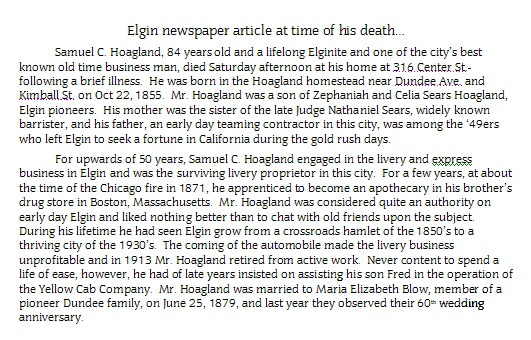Illinois History
Wealthy Elgin Youth Shot by Caddie Master – 1929

*****
Chicago Daily Tribune
April 28, 1929
Wealthy Elgin Youth Shot by Caddie Master
Wilder M. Bosworth, 26 years old, member of a wealthy Elgin family, was shot and critically wounded early this morning as he sat with a party of friends amid a crowd of dancers and diners in El Rora Inn, on the Lincoln highway, in North Aurora. Emmett Lyons, 24 years old, caddie master at the Aurora Country club, was seized as Bosworth’s assailant and locked up at Geneva.
Café Crowded with Dancers
Bosworth, with Miss Evelyn Kingsley, 24 years old of Elgin, and three couples, went to the Inn shortly before midnight. The party was seated at a table in the large room where an orchestra was playing and the dance floor was crowded. Witnesses said that Lyons, who appeared to have been drinking, was strolling among the tables chatting with other guests. Suddenly he approached the Elgin party’s table and addressed Bosworth.
“How would you like to get shot?” he is reported to have said.
Rushed to Aurora Hospital
Then without another word he drew a pistol and fired as Miss Kingsley ran screaming across the floor. The bullet struck Bosworth in the abdomen. Two deputy sheriffs, Clarence Sayre and Charles Anderson, who were in the place, dashed through the terrified crowd and seized Lyons. Bosworth was hurried to St. Joseph’s hospital in Aurora.
Bosworth is the son of the late F. H. Bosworth, coal and lumber merchant of Elgin. His uncles Henry I. and Alfred Bosworth, are retired Elgin bankers. It is believed Bosworth and Lyons were strangers.
*****
Seattle Daily Times
April 29, 1929
Seattle, Washington
Caddy Master Takes Eight Drinks and Shoots Stranger
“What Happened?” Asks Golf Club Employee When He Wakes Up in Jail; Victim Smiling When Hit by Bullet
By Associated Press
Aurora, Ill., Monday, April 29.
“Where do you want it?” asked Emmett Lyons, 25-year-old caddy master of the Aurora Country Club, pointing a revolver at Wilder M. Bosworth, 23; “in the stomach or in the head?”
Bosworth, one of a party of young men and women seated in the El Rora Inn smiled. He did not think this man he never before had seen would shoot. He was still smiling when the weapon sent a bullet into his abdomen.
Lyons awoke in jail yesterday wondering why he was there.
“I must have been pretty much under the weather to be brought here,” he said to the jailer. “What happened?”
The jailer told him that Bosworth, member of a prominent Elgin family, had been seriously wounded.
George Carbary, prosecuting Attorney of Kane County, said he would pay particular attention in the investigation to the liquor angle, but believed no liquor angle, but, believed no liquor had been sold at the inn. Lyons told arresting officers that he had eight drinks from a friend’s bottle shortly before the shooting. He carried a pistol, he said, because he sometimes acted as night watchman at the country club.
*****
Decatur Evening Herald
Monday, April 29, 1929
Decatur, Illinois
CADDIE MASTER HELD FOR SHOOTING STRANGER
AURORA—April 29—Emmett Lyons 25 caddie master awoke in jail here to be told that he had sot and probably fatally wounded another youth, a stranger to him.
The victim of the shooting Wilder M. Bosworth, 23 was reported near death with a bullet wound in his abdomen.
The shooting occurred at a dance hall. Witnesses told police that Lyons apparently intoxicated approached a table where Bosworth was seated with seven girl companions and demanded one of the girls to dance with him.
Thy ignored him and Lyons drew a gun and shot Bosworth.
*****
Sterling Daily Gazette
Friday, May 10, 1929
FORGIVING MOTHER MAY SAVE THE CADDY
AURORA, ILL—(A.P.)—A mother’s capacity to forgive may save Emmett Lyons, young caddy master, from prison.
Last April 27 Lyons shot and seriously wounded Wilder Bosworth at a dance. Bosworth was a stranger to him. Lyons was drunk for the first time in his life.
“It was the liquor, not the boy,” the mother of Bosworth told State’s Attorney George D. Carbury in asking him not to prosecute Lyons.
Bosworth is recovering from the wound.
*****

Franklin Smith Bosworth (1832-1919)
Franklin Smith Bosworth (1832-1919)
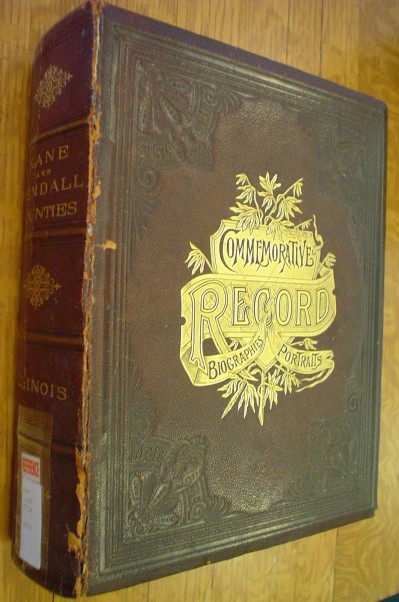
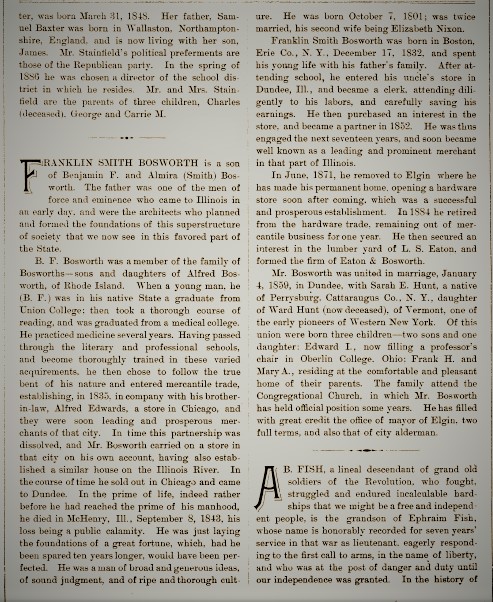
Franklin S. BOSWORTH – a native of Boston, Erie Co., New York, and son of Benjamin F. and Almira SMITH BOSWORTH. The father was born in Greenfield, New York, and was the son of Alfred BOSWORTH, born in Bristol, Rhode Island, of English parentage. Alfred came west in the fall of 1839, to Dundee, Ill. where he died in June 1861. He followed the hatter’s trade, and later farming. He married Olive CHILD of New York, and they had 6 children: Benjamin F., Oliver C., Increase C., Lucinda C., Mary C. wife of Harry WEED, Lucinda wife of Alfred EDWARDS and Abbie M, wife of Benj. SIMONDS; all are now deceased.
Dr. Benjamine F. BOSWORTH the father practiced medicine til his removal to Illinois; locating in Chicago in 1856, he engaged in merchandising in that place until his removal to McHenry, Ill where he conducted a mercatile establishment until his death in Sept. 1843. (transcribers note: these dates are as given. Perhaps reversed?)His wife was the daughter of Amos SMITH, of NY.
Franklin S. BOSWORTH, their only child, was born Dec. 17, 1832. He began merchandising in 1852, in connection with I.C. BOSWORTH, at Dundee, Ill. until June 1871, when he removed to Elgin. There he pruchased [sic] interest in an east side hardware store, until Sept. 1883 when he sold to Metcalf and Reed. 1888 he purchased part of a coal and lumber yard – 1896 he became partners with his son Frank H. BOSWORTH.
Jan 1859 he married Miss Sarah E. HUNT of Dundee, daughter of Ward E. and Mary HUNT, her father a native of Vermont. 4 BOSWORTH children: Reuben H., Edward, married to Bertha McCLURE of Elgin; Mary, wife of Walter SKEELE; and Frank H.
Mr. BOSWORTH was elected mayor of Elgin in 1880, for 2 terms.
Biographical Record of Kane Co., Ill.S.J. Clarke Publishing Co.Chicago, Ill 1898 page 42

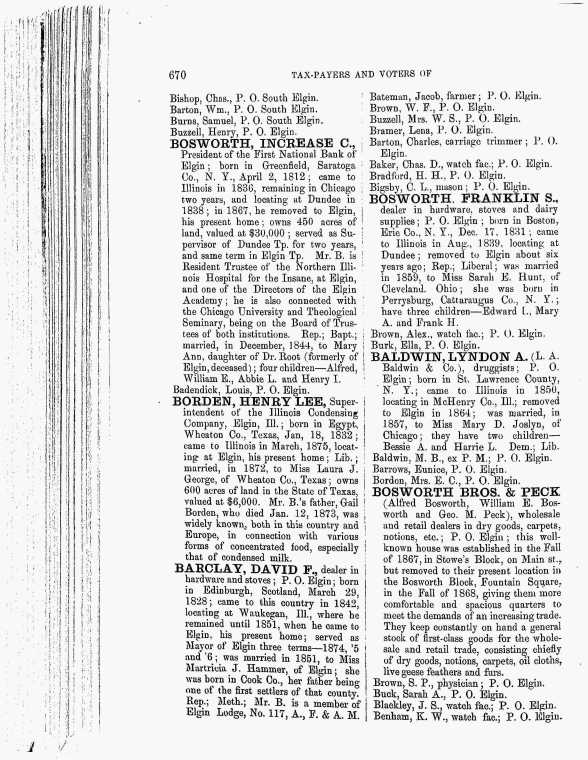
Republican Liberal, Mayor of Elgin, Illinois. He was elected a member of the city council in 1879, and in 1880 was elected mayor of Elgin, filling that office for two consecutive terms. Progressive administration.
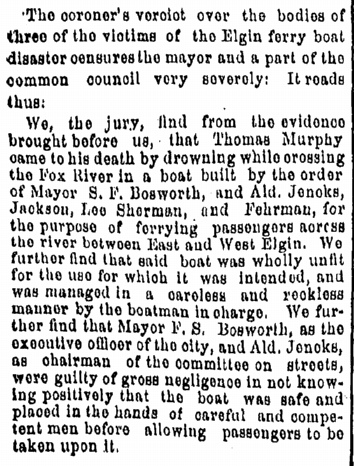
The good, the bad and the ugly truth…
Relationship between Franklin Smith BOSWORTH & Me
Franklin Smith BOSWORTH (1832 – 1919)
2nd great-grandfather
Frank Hunt BOSWORTH (1870 – 1919)
son of Franklin Smith BOSWORTH
Dr. Wilder Morris BOSWORTH Sr., D.D.S. (1905 – 1990)
son of Frank Hunt BOSWORTH
son of Dr. Wilder Morris BOSWORTH Sr., D.D.S.
Deborah FLUDE (1800 – 1847)
Deborah FLUDE Knott (1800 – 1847)
My 4th great-grandmother
daughter of Deborah FLUDE
daughter of Lucy Flude KNOTT
son of Maria Elizabeth BLOW
daughter of Frederick Judson “Fred” HOAGLAND
son of Helen Marie HOAGLAND
The daughter of Capt. Frank Hunt BOSWORTH II
Forget Me Knott
BBC Leicester’s Tony Wadsworth goes in search of a Leicester woman who was born, married and buried in the same street.
How often do you pass familiar buildings, statues and objects in the street without giving them a second thought?
One sunny day BBC Leicester’s Tony Wadsworth stopped to take a look round the churchyard he walks past everyday, and found one woman’s remarkable story amongst the gravestones.
It got him thinking about the area around St. Nicholas Church and how it had changed since her days in the 1800s, and even in the last 50 years.
Deborah’s Death
Deborah’s death certificate states that she died of “enlargement of the liver” and “heart disease”.
BBC Leicester’s Julie Mayer spoke to Dr Clive Harrison to find out what could have caused Deborah’s poor health…
Leicester in the mid 1800s was a very different place from the city we know today and the environment would have affected everyone’s health.
In 1813 the Inspector of Nuisances, George Brown painted the city conditions as a radical risk to the health of its residents.
He said the River Soar was “torpid and turbid”, describing parts of it as an “open cesspool” emitting “pestiferous gasses which cause disease of the most malignant and mortal character”.
Doctors of the time often didn’t understand much more about disease than their patients; miasma, the belief that illness came from bad smells, was a popular concept.
Infant mortality was particularly high with a fifth of children dying before they reached the age of one.
In the 19th Century diarrhoea, consumption, scarlet fever and lung infections were all common causes of deaths.
With people living in cramped conditions, next to cesspits, abattoirs and stables, Clive believes it’s no wonder disease was rife.
Before the time of the NHS and antibiotics, city residents would normally be treated by local doctors who used reference books to give prescriptions from their own pharmacies.
There was just one hospital in the area during the 1800’s. Leicester Infirmary was founded in 1771 but was only open to a small section of society.
Overall Dr Clive said it was unsurprisingly Deborah had died of disease and all things considered she didn’t do too badly to last until 47 years-old: “I’d have said she was almost elderly.”
Life after Deborah
Although Deborah’s grave clearly marks her marriage to James Knott, her husband and children do not rest in the same churchyard.
Peter Cousins searched the 1851 census but was unable to find their names, “Husband, children – just disappeared off the face of Leicester.”
After quite a bit of thinking and investigating Peter traced down the family’s movements after the death of Deborah.
An 1849 shipping list reveals that James Knott, his sons William and Fredrick, and daughter Elizabeth, emigrated to America.
The travelled on the Guy Mannering ship on her first East-West voyage from Liverpool to New York on 22 May 1849.
The journey to the new world and their new home took 38 days.
After digging a bit deeper Peter found the Knott’s settled in Illinois the next year, with what appears to be a young wife for James:
“So he’s not only gone to start a new life, it looks like he’s started a new family.”
St. Nicholas Church, Leicester
In Search of Deborah
BBC Leicester’s Tony Wadsworth and Julie Mayer went in search of the woman who was born and buried on the same street in Leicester…
Deborah was born in 1800 on St. Nicholas Street, which is now a continuation of the High Street – just round the corner from the BBC Leicester studios.
At that time Leicester’s population would have rested at around 17,000 people. Her particular neighbourhood was small but densely inhabited.
Her unusually modern name, which first drew Tony to her story, was passed on from her older sister who died in infancy just a year before her arrival in the world.
She married James Knott in 1822 at St. Nicholas Church, at the age of 22. Find out more about marriage in the 1800s…
Weddings at this time would have been simple and quiet affairs, with just a few close family members witnessing their solemnisation of matrimony.
Local Historian Richard Gill commented, “this notion that we have to have 150 guests at your wedding and you have a huge slap up meal afterwards, that is actually middle to late 20th Century.
“It didn’t happen for my parents in the 1920s.”
A Different Life
Deborah continued to live with her husband on the same road she grew up on, raising six children in the process.
Local genealogist Peter Cousins discovered that at the time of the 1841 Census the children ranged from between three and 16 years-old:
“They were quite regular in their habits, you might say!”
James worked as a shoemaker, which was a common profession in an area home to many shoe factories, however Mrs Knott is likely to have been a housewife.
It is difficult to know how comfortably the Knotts lived as James’ specific position is unknown and could range from business owner to manual worker.
However Richard believes there may be some clues to the family’s wealth in Deborah’s gravestone – a smart but not overly elaborate piece made from local Swithland slate:
“This would rather suggest that there was at least sufficient money to memorialise her when she died.”
Deborah’s life in the 1800s would have been a very different experience to the Leicester women of today.
There were no aeroplanes, no electric light bulbs, no phones, no water pipes delivering fresh water, no flushing toilets, no NHS, and definitely no television or radio!
Leicester: 1800s
With the St. Nicholas area now home to several car parks and a developing park and ride scheme it is particularly interesting to consider that Deborah would have never seen a motor vehicle.
Very few areas of Leicester would still be recognisable to Deborah now, including the Guildhall, five medieval churches, a few chapels, the City Rooms, and a small network of streets south of St. Martins.
Richard said, “In the period in which she lived, that first half of the 19th Century, Leicester was very different and the sort of Leicester we think of as Victorian Leicester came more or less as was dying. So very little survives.”
Deborah died on 15 May 1847 at the age of 47 and was buried in the grounds of St. Nicholas Church in Leicester, where she remains to this day.
It may seem young to us now, but Richard believes it wouldn’t have been at all shocking in the 1840s:
“No drains, no deposal sewage, clean water uncertain – so one was pray to all kinds of things.
“And medicine was really just a case of nursing people, no antibiotics or anything like that, and often the flus in the winter and summer diarrhoea carried people off.
“So it may well be some people thought, ‘well she might have lived longer’, but 47 wasn’t bad.”
last updated: 04/09/2009 at 09:34
created: 07/07/2009
BBC
The story about Deborah as documented by Tony Wadsworth can be heard by clicking on this link and following the links within the story:
http://www.bbc.co.uk/leicester/content/articles/2009/07/07/deborah_knott_feature.shtml
Samuel Campbell Hoagland 1855–1940, Early Elgin, Illinois, Livery and Transportation
“Sam was a prudent businessman who maintained a card index of every animal and piece of equipment. He retired in 1913. He owned 26 horses, 11 full-sized closed carriages, 3 hearses, 3 fancy conveyances, opera hacks, pallbearer wagons, two seat carriages and one-seat light driving rig.”
Wagons to taxicabs: 4 generations of Hoaglands haul Elginites by E. C. Mike Alft
Samuel Campbell Hoagland was my great great grandfather.
son of Samuel Campbell HOAGLAND
daughter of Frederick Judson “Fred” HOAGLAND
son of Helen Marie HOAGLAND
the daughter of Capt. Frank Hunt BOSWORTH II
Samuel Campbell Hoagland was born on December 22, 1855, in Elgin, Illinois. His parents were Zephaniah and Celia (Sears) Hoagland.
Sam married Maria Elizabeth Blow on June 25, 1879 in his hometown. According to family history notes by my grandmother, the couple was married at the residence of D.R. Jencks, Rev. D.B. Cheney officiating. However, Robert B. Mogler, another Sam Hoagland descendant, has stated their marriage certificate shows they were married a the First Baptist Church in Elgin. They had two children during their marriage, a son Frederick Judson “Fred,” was born on June 12, 1880, and a daughter, Jennie May “Jane,”born on November 14, 1881. Both children were born in Elgin.
Hoaglands
For more than a century, through four generations and changing modes of transportation, the Hoaglands hauled freight and people around Elgin.
Zephania Hoagland’s aunt and uncle pioneered east of town in Hanover Township in 1837. Born in Steuben County, New York, Zeph also was an early arrival here, but didn’t settle down in Elgin until he had tried his luck as a’49er seeking gold in California. Zepbania became a teamster whose horse-drawn wagon carried goods around the little mill town that grew into an industrial city during his lifetime.
Zeph’s son, Sam C. Hoagland, was born in Elgin in 1855. He worked for his father and then purchased his own one-horse express wagon in 1876. The livery (a stable keeping horses and vehicles for hire) he bought four years later became one of Elgin=s largest. He also ran buses to and from the factories and supplied a big Tally-Ho wagon for picnics.
Sam Hoagland was a prudent businessman who maintained a card index on the cost of every animal and piece of equipment in his stable. His records indicated what each horse had eaten and earned. He also knew each one’s habits. When a drummer had rented a rig to go to Dundee, be complained on returning that the horse had balked. Sam charged him more than originally agreed because the rig had gone all the way to Algonquin. How did Sam know? Old Betsy never stalled except on the Algonquin bill.
Some customers desired well-dressed drivers as well as a carnage. In the Hoagland wardrooms were 15 outfits of fur coats, gloves, and caps. There were enough neatly brushed silk hats to costume a half-dozen minstrel shows.
By the time be retired in 1913, Sam Hoagland owned 26 horses, 11 full-sized closed carriages, three hearses, three fancy conveyances, opera hacks, pallbearer wagons, two-seat carriages, picnic wagons, and one-seat light driving rigs of all descriptions.
Sam’s son, Fred J. Hoagland, was born in Elgin in 1880 and joined the business after leaving high school. When the livery closed, he adapted to the motor age and started the Hoagland Taxicab Company with three Model-T Fords and two Reos, all black. Meters were introduced in 1919, and the original fare they tallied was 25 cents for the first mile and 10 cents for each succeeding two-fifths mile. After World War I, Fred began buying Yellow cabs manufactured in Chicago by John Hertz, and the firm’s name was changed to the Elgin Yellow Cab Company.
The early Yellows had tonneaus in which only the passenger compartment was enclosed. The driver was in the open air, exposed to rain and snow. After Hertz sold out to General Motors, Hoagland switched to Chevrolets.
Two-way radios, which reduced cost and response time, were introduced in 1946. At its operating peak in the 1950s, Elgin Yellow had about 60 full and part-time employees, including three full time dispatchers, two telephone operators, maintenance shop repairmen, and drivers. The firm had 18 cars on the streets in the summer and 25 in the winter. The cars averaged about 7,000 mile per month. Eight new cars were purchased each year. By the end of the decade, Elgin Yellow had switched from Chevrolets to Checkers made in Kalamazoo, Michigan.
Fred’s son, Charles Hoagland, was born in Elgin in 1913. While still a boy, he learned the ropes by guiding new drivers around the city. He eventually became a partner in the business, withdrawing in 1964, but was driving his private livery until he reached the age of 70.
—–
ElginHistory.com – Elgin: Days Gone By – E. C. Alft
At the age of 84 years old, Sam died and was buried, alongide his wife, Maria, in Elgin’s Bluffside Cemetery. The following was transcribed by my grandmother, Helen Marie Hoagland who was his granddaughter, from a newspaper article at the time of his death. She did not state the source of the death notice:
